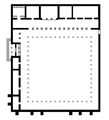| Context: | Priene |
| Type: | Gymnasium |
| Summary: | Gymnasium adjacent to stadium, below center of city, inside southern city wall |
| Date: | ca. 130 BC - ca. 100 BC |
| Dimensions: | Dimensions of palaestra: 35.11 m. x 34.35 m. Width of northern colonnade between palaestra and row of rooms 4.90 m. Width of ephebeum 9.49 m. Dimensions of wash room 6.90 m. x 7.48 m. Height of facade of ephebeum: at least 7.50 m. |
| Region: | Ionia |
| Period: | Hellenistic |
Architectural Order:
Doric, Ionic and Corinthian: the colonnades of the palaestra were of the Doric order; the two columns at the entrance to the ephebeum in the north were Ionic; within the ephebeum, engaged Corinthian half-columns decorated the upper portion of the rear wall. The propylon or monumental entrance to the gymnasium in the west contained Doric columns (Wiegand and Schrader describe it as Ionic, Schede as Doric).
Plan:
Square central palaestra surrounded by colonnades; double colonnade in north, leading to a row of at least five rooms; in the west, an additional row of four rooms and the monumental entrance to the complex. The colonnade in the north was two-storied.
Date Description:
Technical similarities in masonry to mid-second century B.C. structures at Priene; mid-second century B.C. inscription from North Stoa referring to construction of gymnasium; style of bucrania and garland frieze; students' names carved on marble blocks in ephebeum date at the latest to the republican period, and provide evidence for the use of the building in this period.
History:
An inscription found in the North Stoa of Priene and dating to the mid-second century B.C. refers to the construction of a new gymnasium, the lower gymnasium. Funding for the new building was delayed until ca. 130 B.C., when two brothers, Moschion and Athenopolis, donated considerable funds for its construction. Graffiti of Republican date indicate that the gymnasium was still in use at this time. Unlike many Hellenistic gymnasia of Asia Minor, it was not converted into a bath building in the Roman Imperial period.
Other Notes:
Typologically, the lower gymnasium combines the characteristics of a simple, square palaestra surrounded by Doric colonnades, with characteristics reminiscent of agora architecture, here represented by the double colonnade in the north leading to the Ionic facade of the schoolroom or ephebeum. The lower gymnasium forms part of a complex together with the adjacent stadium, although there are differences in their level and orientation. In some respects the gymnasium at Priene accords with Vitruvius' description of a typical Greek palaestra, surrounded by colonnades to provide shelter from inclement weather, and with rooms for instruction, washing and philosophical discussion behind the colonnades.
Other Bibliography:


